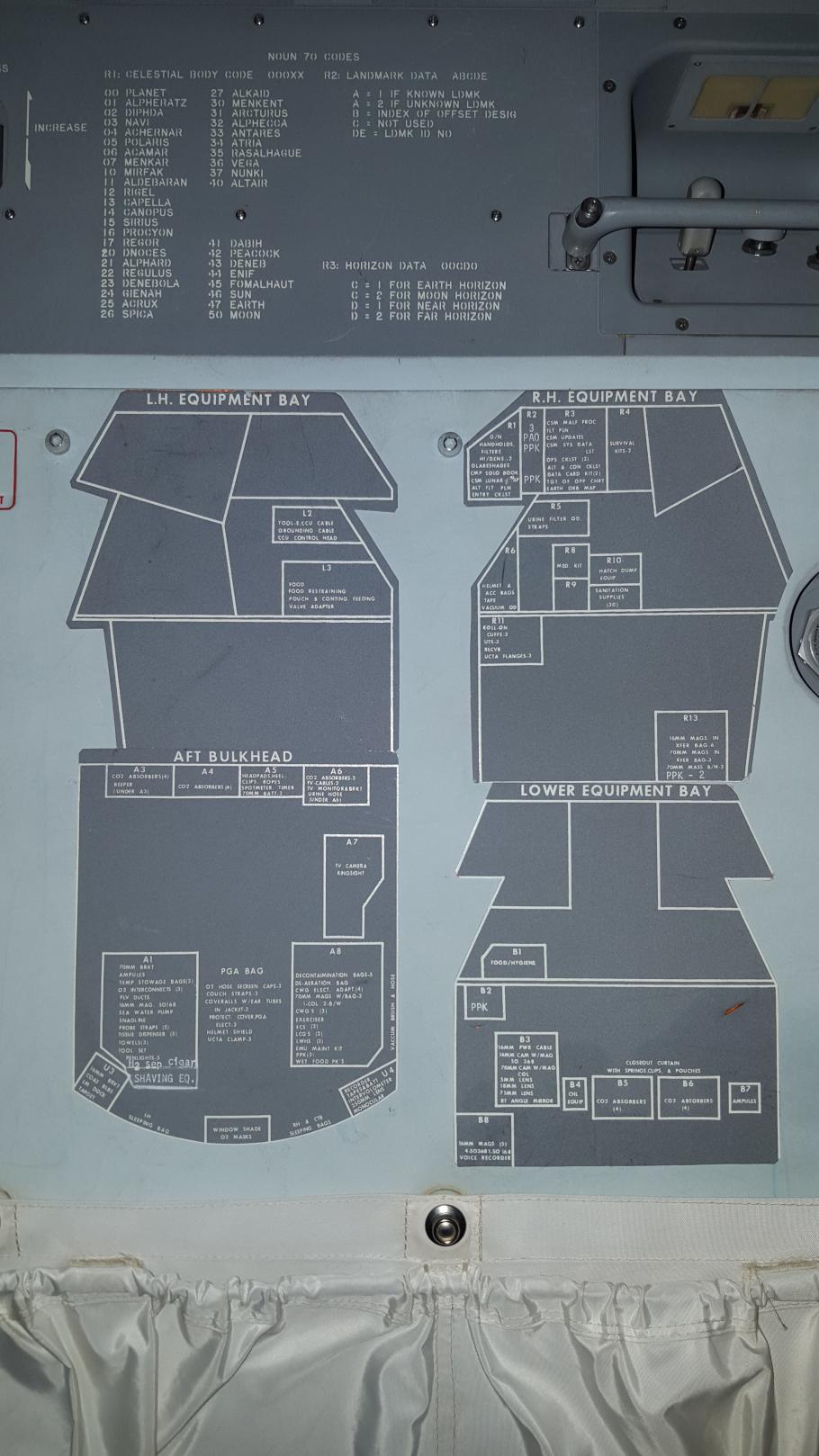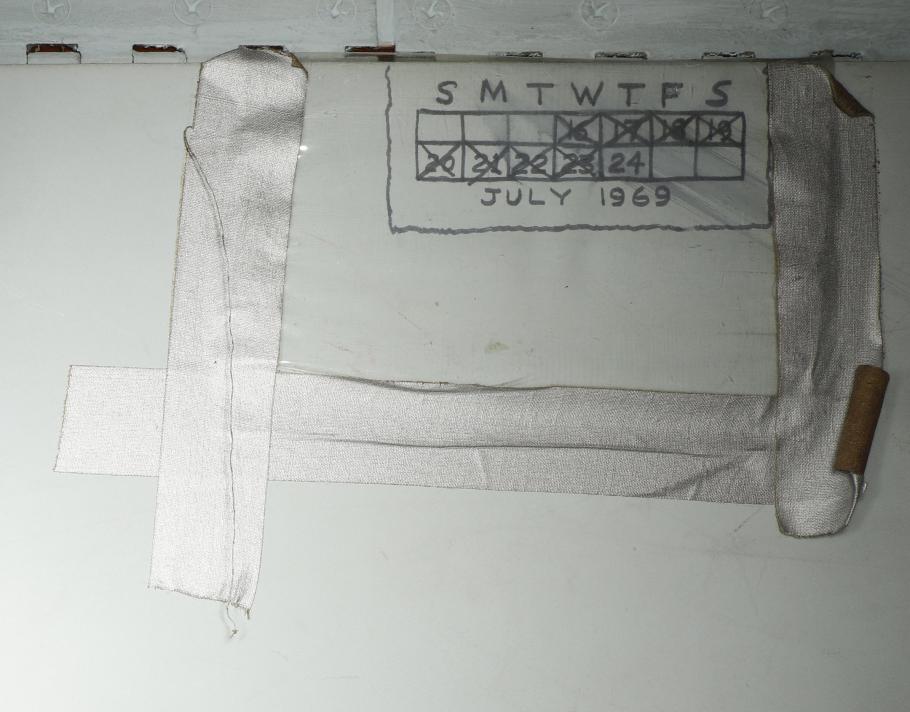Last year I wrote about the Armstrong purse, discovered by Neil Armstrong’s widow, Carol, in their home shortly after Neil’s death in 2012. That stowage bag of small (but historically significant) items from the first lunar landing was a reminder that the story of Apollo 11 continues to be told as new details emerge in unexpected places. Recently, we have again been reminded that a curator’s work is never done. During the course of a project to produce a detailed 3D model of the Apollo 11 Command Module Columbia, we were able to observe and record some hand-written notes and markings in areas of the spacecraft that have been hidden from view for more than 40 years. The notes, figures, and a calendar, presumably improvised during the mission, tell us something about what life was like on the way to the Moon and back. The notes can be compared with audio and recorded transcripts of communication between Columbia and Houston to suggest when and by whom they were written, providing new insights into of one of humankind’s greatest adventures. Over the past several months, the curatorial, collections, and conservation staffs at the National Air and Space Museum have been working diligently with the Smithsonian Digitization Program Office and their technical partner, Autodesk, to facilitate the capture of very high-resolution laser scanning data and photometry of the exterior and interior of the Command Module. The intention is to stitch together data from several different sources, using state-of-the-art software, to produce a stunningly detailed three-dimensional model. We hope to share the results of that work with the public in the future both online and in exhibitions. Before then, this is an initial report, based on preliminary images, on some of those unexpected “writings on the wall” that have we have seen for the first time. Explore the 3D model.
Looking for Eagle
One important detail that has puzzled experts is how much work Michael Collins, orbiting the Moon alone in Columbia, put into locating the Lunar Module (LM) Eagle on the surface below with the Command Module’s telescope. Mike Collins used this map to mark, unsuccessfully it turned out, the Eagle’s location on the Moon. On the map, we can see the estimated LM locations given to him by Houston. These are indicated with combinations of lines, arrows, circles, and one ellipse. Now we have some new information. Just to the left of the navigation station, at which Michael Collins would have stood to access the Command Module’s sextant and telescope, is a relatively clear surface. The surface has several sets of numbers.
A careful review of the audio ground-to-space transcripts shows that all of the entries on the right side of the lower panel refer to various sets of coordinates sent from Houston, the very ones recorded by Collins on the map linked above. You can read a detailed discussion on what was previously known about this process by our friends at the Apollo Lunar Surface Journal, (Search the page for “LAM-2”to find a discussion and links to the transcripts of ground-to-space communications of attempts to help pinpoint the Eagle on the surface of the Moon). We are already working with the Journal to prepare a far more detailed account that will include what can be learned from these newly discovered entries.
A Place for Everything, and Everything in its Place
The work on the scanning project has also nicely supplemented another project. Over the past few months we have independently been working to construct an electronic database of all the items stowed on the spacecraft that took astronauts to the Moon. That laborious process of transcribing the printed “stowage” lists has recently been completed online by a team of dedicated volunteers. Once verified, that data will be made available to the public. The 3D scanning of Columbia complements the stowage lists transcription project nicely, as you will see.
Here is a map of stowage locations we were able to photograph last week. It is just below and to the right of the makeshift writing board described above. The diagram available to the Apollo 11 astronauts essentially mirrors that in the printed listing. At some point during the mission, however, the astronauts apparently improvised a bit on what should go where. Several of the lockers have handwritten labels along with their standard alpha numeric identifiers. Locker R5, for instance, was designated to store auxiliary equipment related to the spacecraft’s waste management system. But early on, it was selected as a repository for urine bags filled before or early in the flight, before the normal waste disposal system became available. The astronauts left a note to themselves on this and at least one other locker with the seeming purpose of reminding them that the new contents of the locker should probably remain undisturbed for the rest of the mission.
Counting the Days
Another newly-discovered bit of astro-graffiti provides some fascinating clues about how the astronauts responded to life inside Columbia. There is a small hand-drawn calendar, just below one of the lockers with the days of the mission crossed out one by one. July 24th, the day of the crew’s near-dawn splashdown into the Pacific, remains uncrossed. Exactly when this was drawn, by which astronaut, and the purposes it served are a matter of conjecture (and much discussion) since it was noted. So far we have uncovered little additional information. We do know that it remains virtually unchanged since the Command Module arrived at the Lunar Receiving Laboratory during the two week quarantine period enforced on the early Apollo Lunar missions. In the image below, taken in 1969, the calendar can be seen just behind technician John Hirasaki, who was quarantined with the Apollo 11 crew after splashdown.
The Best Ship to Come Down the Line
We will continue to study the secrets Columbia holds, nearly 50 years after it completed its mission and for years to come. Columbia isn’t just a piece of machinery, it is a living artifact. As a curator, it is thrilling to know that we can still learn new things about one of the most iconic artifacts in the entire Smithsonian Collection. The inscription below is not among the newly-discovered writings, and has been known to historians for many years. It reads: Spacecraft 107, alias Apollo 11, alias ‘Columbia.’ The Best Ship to Come Down the Line. God Bless Her. Michael Collins, CMP This is a sentiment we have all come to appreciate now more than ever.





